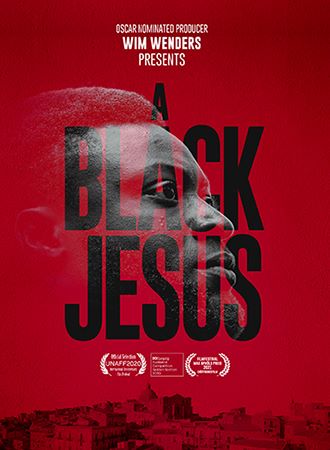
A Black Jesus 2020
Distributed by Outcast Films, 511 6th Avenue Suite 398, New York, NY 10011
Produced by Wim Wenders
Directed by Luca Lucchesi
Streaming, 92 mins
High School - General Adult
Documentaries; Immigration; Race Relations
Date Entered: 09/27/2022
Reviewed by Joseph Baumstarck, Jr., University of Louisville, Southern Baptist Theological Seminary, Ivy Tech Community CollegeA Black Jesus is a documentary film set in Siculiana, Sicily. It focuses on the quest by Edward (and his friends Peter and Samuel), asylum seekers from Ghana, to become part of the most significant yearly event in Siculiana – the carrying of the Black Jesus.
Siculiana is a tiny town in a relatively isolated part of Sicily with around 4500 permanent residents. Several problems beset the permanent residents, including loss of youth who migrate out of the area, loss of jobs in the community, loss of population due to outmigration, an aging population, and a tendency to remain set in old ways and not open to outsiders. Every May 3, Siculiana celebrates the feast of its patron Saint with a parade in which bearers carry the town's famous Black Jesus Crucifix through the streets on their shoulders. Carrying the Black Jesus is considered a great honor despite the heavy burden of physical labor required to perform this duty. The Black Jesus is a crucifix sculpture that depicts Jesus as black and has been a well-known landmark in Siculiana for hundreds of years, where it spends most of the year above and behind the altar in a local church. Since Siculiana is a town of migrants, perhaps the display of a black Jesus in a town of all non-black people is not surprising.
Four years prior to this documentary, one of the rapidly failing local hotels was converted to a refugee center, at one point housing 1000 asylum seekers. Despite Siculiana's problems, many of them due to a shrinking population base, there was little to no attempt by the locals to interact with the refugees. Once a refugee's immigration status became established in the community, it was almost impossible for them to find a job, alternative housing, or form relationships with the local population. The film documents the deep distrust between many Siculiana residents and the refugees, despite lacking evidence of any refugee-created problems. Also apparent is that many refugees give up interacting with the people of Siculiana and spend their time in the refugee center trying to better their chances of getting a permit to immigrate to other places. The film does a good job documenting efforts by some refugees to better their situation and briefly mentions some of the resources available to them at the center.
2017 and 2018 are different because Edward and his friends from Ghana decide to seek permission to assist in carrying the black Jesus at the 2018 festival. After a conversation with Edward, one local clergy agrees to assist the three in achieving their mission. Although the film depicts no actual resistance to their application, it is clear that the clergyman takes some risk in furthering their request. Edward is fascinated by the back Jesus because it is the first depiction of Jesus as black that he has seen. The film is never clear about Edward's religious leanings, but it is evident that he feels an affinity for the Jesus who, like he is black.
The documentary does little with the story of the black Jesus itself but focuses on the interaction between the refugees and the townsfolk. Unfortunately, much of this interaction is disjointed, and there is minimal storyline connecting the vignettes in the film. The festival itself is also short-shifted, with the whole focus on the carrying of the crucifix. The juxtaposition between the refugees, who could solve several of Siculiana's problems, a black Jesus crucifix, an annual festival in which bearers carry this black Jesus through the streets, and a predominantly black refugee population poses a fascinating tapestry that explores the persistent separation between the townspeople and the refugees. The filmmakers quickly assume racism is the problem, but it seems apparent that the significant factor is a simple distrust of anything new that is not a longstanding part of how things have always been done.
Overall, this documentary is slow-moving in many places and makes assumptions appearing unwarranted by the evidence in the film. A rating of recommended is justified because the juxtaposition of the above elements lends a high degree of interest and allows many hours of interesting exploration of these and related topics. This film would work well to stimulate discussions in an academic and social setting that might impact city planning, Humanities courses, immigration, racism, and encourage some individuals to work to accomplish a dream, even in the face of seemingly insurmountable obstacles.
Awards:Best Debut Award at Millennium Docs Against Gravity; Doc Alliance Award; Amnesty International Poland Award
Published and licensed under the Creative Commons Attribution 4.0 license. Anyone can use these reviews, so long as they comply with the terms of the license.